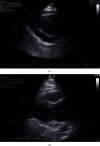Pericardial Effusion-Associated Hyponatremia
- PMID: 32765912
- PMCID: PMC7374206
- DOI: 10.1155/2020/8847666
Pericardial Effusion-Associated Hyponatremia
Abstract
Pericardial effusion has been identified as a rare cause of hyponatremia. In most patients, pericardiocentesis results in rapid correction. We describe a 67-year-old male who presented with pericardial effusion-associated hyponatremia secondary to cardiac resynchronization therapy-D placement that resolved following evacuation. In addition, we review the literature on pericardial effusion-associated hyponatremia.
Copyright © 2020 Ahmed A. Hanfy et al.
Conflict of interest statement
The authors declare no potential conflicts of interest.
Figures



References
Publication types
LinkOut - more resources
Full Text Sources

